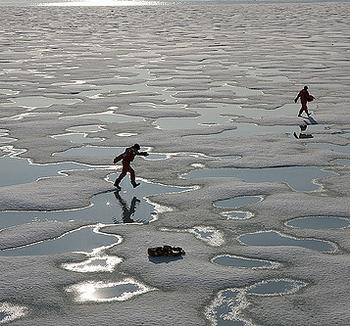 全球性環保組織世界自然基金會(WWF)在一份新的報告中指出,北極地區持續暖化可能會導致全球氣候變遷和引發波及全球1/4人口的洪災。
全球性環保組織世界自然基金會(WWF)在一份新的報告中指出,北極地區持續暖化可能會導致全球氣候變遷和引發波及全球1/4人口的洪災。
該報告發表於由世界氣象組織(WMO)主辦,在日內瓦舉行的世界氣候大會-3。2,000多名代表與會為全球氣候變遷預測系統架構進行商討。
根據一份同業審查的科學報告,過去幾十年來,北極的氣溫比全球平均溫度上升了幾乎兩倍。該報告警告說,持續暖化的現象很可能會讓北極凍土中的溫室氣體釋放出來。
報告還警告說,北極海冰解凍加上格陵蘭和南極西部冰層的融化,截至2100年有可能導致全球海平面升高約1.2公尺(4英尺),較原先預期來得高。
科學家估計,導致21世紀全球暖化的排放物,有近50%是源於非二氧化碳污染物,包括黑炭、低濃度臭氧、甲烷和氮化合物。
黑碳的排放源來自焚燒森林、草原和作物殘餘物;生物能、動物糞便、烹飪、柴油引擎和燃煤發電站燃燒不完全所致。
黑碳是諸多造成每年160萬到180萬人因接觸室內空氣污染物而過早死亡的原因之一。而因接觸室外空氣污染物而致死的人數則有80萬人。
根據不同的研究人員表示,黑碳可能就氣候變遷短期内的影響比二氧化碳的暖化效應高了20%多到50%之譜。而遺留在冰雪上的黑碳排放物,包括在北極和青藏高原的喜馬拉雅山,其破壞性特別大。
對流層臭氧,包括近地表臭氧為一種主要的溫室氣體,不僅危害人體健康,更嚴重地破壞農作物和生態系。
另一項由美國麻省理工學院所做的研究估計,美國5%的穀物產量受到地面臭氧的影響,並且截至2100年全球糧食產量可能會減少40%。
<對流層臭氧存在於地表至海拔15公里處,是一氧化碳、氮氧化物等物質與揮發性有機化合物、溶劑等石化產品的排放物混合後,經陽光照射產生。
研究人員估計,對流層臭氧的溫室效應可能是二氧化碳暖化效應的15%至20%。
不斷上升的缺氧海洋死區對於微弱並已近枯竭的魚類存量引發愈來愈多的關注。同時,氮化合物的排放物也因其人造施肥的效果而導致植被和生態系的變化。
Continued warming of the Arctic could lead to global weather changes and flooding that affects one-quarter of the world's people, finds a new report by the global conservation organization WWF.
The report was released in Geneva at the World Climate Conference-3, hosted by the World Meteorological Organization. Some 2,000 delegates are meeting to lay the groundwork for a global system of climate change forecasting.
Arctic air temperatures have risen by almost twice the global average over the past several decades, according to the peer-reviewed scientific report, which warns that further warming could release more greenhouse gases now trapped in the Arctic's frozen soil.
The combination of thawing Arctic sea ice and melting ice sheets in Greenland and West Antarctica is likely to raise global sea levels by about 1.2 meters (four feet) by 2100, more than previously thought, the report warns.
Scientists estimate that nearly 50 percent of the emissions causing global warming in the 21st century are from non-CO2 pollutants, ranging from black carbon and low-level ozone to methane and nitrogen compounds.
Black carbon is emitted by the burning of forests, savannas and crop residues, by the inefficient burning of biomass and dung for cooking and by diesel engines and coal-fired power stations.
Black carbon is among a suite of air pollutants linked to 1.6 million to 1.8 million premature deaths annually as a result of indoor exposure and 800,000 as a result of outdoor exposure.
Black carbon's likely near-term climate change contribution ranges from 20 plus percent to up to 50 percent of the CO2 warming effects, according to various researchers. Especially damaging are the black carbon emissions that end up on snow and ice, including the Arctic and Himalayan Tibetan Plateau.
Tropospheric ozone including near-surface ozone is a major greenhouse gas, harms human health and is linked to significant damage to crops and ecosystems.
Another study by the Massachusetts Institute of Technology estimates that five percent of cereal production in the United States is lost to ground level ozone and that by 2100 crop yields globally could be cut by 40 percent.
Tropospheric ozone, which occurs from the ground up to 15 kilometers in altitude, is generated by substances such as carbon monoxide and nitrogen oxides mixing with emissions of petroleum products like volatile organic compounds and solvents in the presence of sunlight.
Researchers estimate that the contribution of tropospheric ozone to the greenhouse effect could range from 15 to 20 percent of the CO2 warming.
The rising number of dead zones, deoxygenated areas of seas and oceans, is raising concern over already vulnerable and depleted fish stocks. Meanwhile, nitrogen compound emissions are also contributing to changes in vegetation and ecosystems as a result of their artificial fertilizing effect.



